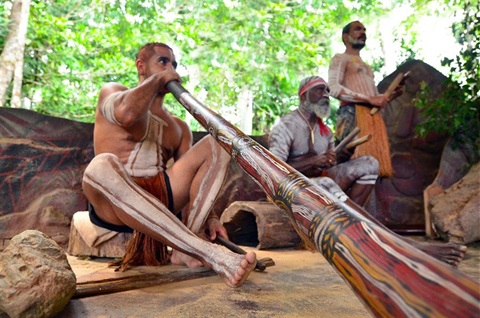Lismore's First Peoples

"As Aboriginal people we have different ideas and views about our existence to that of non-Aboriginal people. We view the world in a holistic manner, seeing people and nature as part of the whole, connected by their very existence and descended from our creator ancestors. The key to our very survival is cooperation and coexistence with the forces of nature, the spirit world, and with our fellow man. We are all part of the natural order and our cultural beliefs and practices should not be subject to Western scientific analysis. In other words, our culture should never be broken down and compartmentalised. If you can’t see the interconnections and interrelations that dominate our culture, then you aren’t looking with an open mind."
– Wiyabal Elders Joint Statement
Traditional custodians
Australian Aboriginal culture is the oldest living continuous culture in the world. It is kept alive through language, art, dance, performance, sharing Dreaming stories and the protection of significant sites and objects.
At the time of the British invasion, the Bundjalung Nation consisted of more than 13 different tribes or dialect groups, each containing several clans or extended family groups. The Bundjalung Nation stretches from the northern banks of the Clarence River up to the Logan River in Queensland and west to the Great Dividing Range near Tenterfield and Stanthorpe.
European arrival
The arrival of Europeans in the 1840s had a dramatic impact on the lives of Lismore’s Aboriginal people. From the 1860s, their lands were cleared and fenced, forcing them to live in camps on the edge of town.
Government reserves and stations were established, and in 1908, some of Lismore’s camp dwellers were moved to Dunoon Aboriginal Reserve at Modanville where they could farm and live independently. With the planned conversion to a white-managed station in the 1920s, many residents began returning to the town camps.
The Reserve and its school closed in 1929. Objections by white townspeople saw them moved in 1931 – from the camps in North Lismore to a new reserve at Tuncester, 7km away. The reserve was renamed ‘Cubawee’ by its residents, meaning ‘place of full and plenty’. It was closed in 1964. Despite many obstacles, Lismore’s Aboriginal people have retained their cultural heritage.
Renewal
Bundjalung ‘lingo’ is still spoken by local Aboriginal people and some families have maintained a continuous connection to Country.
Bundjalung language and culture entered a period of renewal in the 1970s, with the growing national awareness of Aboriginal people’s right to land and equality. The ?rst major legislation which recognised land rights was enacted in 1976. The earlier policies of protection, followed by segregation and then assimilation, were replaced in the 1970s by those aimed at self-determination.
As the Bundjalung people reasserted their identity and culture, they also formed their own organisations and institutions. The Ngulingah Local Aboriginal Land Council – which manages Nimbin Rocks and the former Cubawee Aboriginal Reserve – was established in Lismore, along with Jarjum Centre Preschool for Aboriginal children. Gnibi College of Indigenous Australian Peoples, an Indigenous education and research centre at Southern Cross University and the Koori Mail national newspaper, were both founded in Lismore.
Today, Aboriginal people work closely with organisations such as Arts Northern Rivers and the Of?ce of Environment and Heritage to ensure their culture is respected, acknowledged and protected.
Sacred sites
Sites which have significance to Lismore’s Aboriginal people are present throughout the region. They include ‘sacred sites’ and places associated with Dreaming stories and customary Lore such as waterholes, springs, waterfalls, caves, mountains and other natural landforms. These sites link the Dreaming to the present, connecting groups and individuals to the land, water, plants, animals and each other. These sites are important for the transmission of traditional knowledge and cultural practices.
Places indicating a past Aboriginal presence such as birthing and burial sites, bora rings, carved trees, middens and campsites are also of significance. They are tangible evidence of past Aboriginal cultural practices and occupation of the land.
Sites associated with European colonisation have also acquired special meaning and include massacre sites, Aboriginal reserves and stations, and places associated with political activism and land rights.
The Dreaming
The Dreaming is the Aboriginal understanding of the world, of its creation and its great stories. It refers to the time when the Ngathang Garr, or spiritual ancestors, first came into being and created the sky, land and water.
Dreaming stories relate the deeds and events of these spiritual beings as they roamed the barren land creating landscape features, plants, animals and humans. During this era of creation, also known as Budgeram, the Lores of existence were handed down to the people outlining their roles within the Cycle of Life. Once the Spiritual Ancestors had created the world and the Lores, they changed into rocks, trees, mountains or other parts of the landscape that became sacred places.
The Dreaming is a continuous linking of the past with the present, the future, the people and the land. Through song, dance, painting, storytelling and ceremonies, the traditional knowledge of the Dreaming has been passed on through the generations for thousands of years.